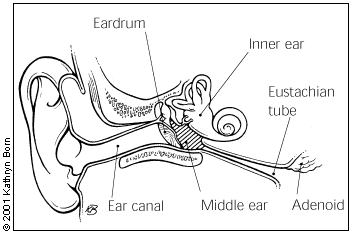
Am Fam Physician. 2001;63(4):771-772
How does the ear work?
The ear works by receiving sound waves and sending messages to the brain. The outer ear includes the part of the ear you can see and the ear canal. The sound waves go through the ear canal and hit the eardrum and cause it to vibrate (see the picture below).
The vibration of the eardrum causes the tiny bones in the ear to move. This movement sends the sound waves to the inner ear.

What causes earaches?
Earaches commonly happen when the ear canal becomes blocked, which keeps fluid from draining out of the canal. Fluid in the middle ear provides a good place for an infection to start. Infection with blockage increases pressure behind the eardrum, causing much of the pain.
The ear canals can become blocked because of allergies, a cold or other infection. In other cases, the adenoid gland near the ear becomes enlarged and blocks the ear canal.
Acute ear infections usually clear up in one or two weeks. Sometimes, ear infections last longer and become chronic. After an infection, fluid may stay in the middle ear. This may lead to more infections and hearing loss.
What are the symptoms of ear infections?
The most common symptoms of an acute ear infection are ear pain (which may be sudden and severe) and fever. If your child is too young to tell you what hurts, he or she may cry and fuss. Your child may also be irritable or listless, have trouble hearing, or not feel like eating.
Will earaches hurt my child's hearing?
Middle ear infections and fluid in the ear are the most common causes of temporary hearing loss in children. Children who have ongoing problems with hearing may have trouble developing their speech and language skills. For this reason, it is important to talk with your doctor if your child has repeated ear infections.
What is the treatment for ear infections?
If your doctor thinks the infection is caused by bacteria, he or she may prescribe an antibiotic. (Antibiotics don't work for infections caused by viruses.) It's important to follow the directions for giving your child the medicine.
Pain relievers like acetaminophen (Children's or Infants' Tylenol) and ibuprofen (Children's Advil or Children's Motrin) can help make your child feel better and reduce fever. Don't give your child aspirin unless your doctor says it's okay.
A warm, not hot, heating pad held over the ear can also help relieve the earache.
Ear drops to relieve pain are sometimes prescribed.
An immunization (“shot”) that helps prevent some ear infections is available. Talk to your doctor for more information.
What can be done to prevent ear infections from returning?
Some children seem to get many ear infections. If your child has had three ear infections in six months or four in one year, your doctor may suggest that your child take a low dose of antibiotic every day, usually during the winter when these infections are most common.
Your doctor may want to see your child a few times when he or she is taking the antibiotic to make sure another ear infection does not happen.
What about fluid that stays in the middle ear?
Your child's hearing may be affected if fluid stays in the middle ear after an infection. This may also lead to repeat infections. Usually the fluid goes away in two to three months, and hearing returns to normal. Your doctor may want to check your child again at this time to see if fluid is still present.
If the fluid stays for more than a few months, your doctor may want to check your child's hearing. Your doctor may recommend ear tubes (tympanostomy tubes) to drain the fluid if your child's hearing has decreased a lot. Ear tubes may also decrease the number of ear infections. These tiny plastic tubes help balance the pressure in your child's ears and allow air into the middle ear so that fluid can drain out down the ear canal.